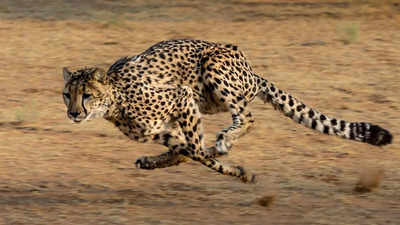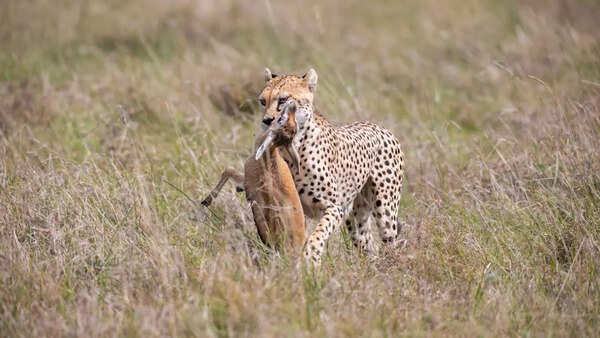Trending
What makes Cheetahs the fastest land animal?
Cheetahs, Earth's fastest land animals, achieve speeds up to 70 mph with unique adaptations. Their slender build, large lungs, and tail aid in sprinting. Fast-twitch muscles enable rapid acceleration, crucial for catching prey. Despite their speed, cheetahs can only sustain it briefly due to overheating. Conservation efforts are vital for their survival, emphasizing the need to protect their habitats. Cheetahs symbolize nature's marvels and our responsibility to preserve biodiversity.

Cheetahs (scientific name: Acinonyx jubatus) are renowned for their unparalleled speed, holding the title of the fastest land animals on Earth. Capable of accelerating from 0 to 60 miles per hour in just three seconds, these big cats can sustain speeds of up to 70 miles per hour over short distances. This extraordinary ability is the result of a unique combination of biological and physiological traits that have evolved over time.
What contributes to it's speed?
The cheetah’s slender, aerodynamic body shape is fundamental to its speed.Weighing between 75 to 150 pounds, their lightweight frame supports rapid acceleration without a significant energy cost. Their long legs and flexible spine work in tandem to increase their stride length and frequency. During a sprint, a cheetah’s stride can measure up to 26 feet, and they can take up to 150 strides per minute. This is complemented by their semi-retractable claws, which provide enhanced grip on the ground, much like the spikes on a sprinter’s shoes.
The cheetah’s remarkable sprinting prowess is intrinsically linked to its specialized respiratory system. With expansive nasal passages, they can draw in vast amounts of air, fueling their large lungs and oversized heart. This anatomical advantage facilitates a surge in oxygen transport to muscle tissues, vital for high-speed chases. During a sprint, a cheetah’s breathing intensifies dramatically, from a resting rate of around 60 breaths per minute to an astonishing 150 breaths per minute. This rapid respiratory rate is crucial for maintaining the flow of oxygen-rich blood, enabling the cheetah to sustain its incredible bursts of speed, which can reach up to 75 miles per hour. The synergy between the cheetah’s respiratory and cardiovascular systems exemplifies evolutionary adaptation at its finest, allowing this predator to excel in its role as one of nature’s most efficient hunters.
At the cellular level, cheetah muscles exhibit a high concentration of fast-twitch fibers, which contract quickly and powerfully. These fibers provide the explosive speed necessary for catching prey, such as gazelles, which are their primary food source. The cheetah’s diet, consisting mainly of these swift ungulates, has influenced their evolution, honing their speed and agility to become successful hunters.
The speed is not without its limitations
The cheetah’s remarkable speed is not without its limits. These magnificent cats can sprint at their top speeds for only 20 to 30 seconds before their bodies reach their limits. To mitigate this, cheetahs employ a clever strategy: they stealthily stalk their prey, closing the gap as much as possible before launching into the chase. By minimizing the duration of their sprint, they reduce the risk of overheating and increase their chances of a successful hunt.
If we talk about their hunting techniques, cheetahs rely on their incredible speed and stealth to approach their prey as close as possible before sprinting to catch it. They often hunt during the day to avoid competition with larger predators. Also, the distinctive black "tear marks" running from the inner corners of their eyes down to the sides of their mouths help reduce glare from the sun and enable them to focus better on their prey.

Conservation efforts
Conservation efforts for cheetahs are critical, as their populations have dwindled due to habitat loss and human-wildlife conflict. Organizations like the Cheetah Conservation Fund, established in Namibia in 1990, work tirelessly to protect these magnificent animals and their habitats. The Cheetah Conservation Fund (CCF), with its holistic approach to conservation, has been instrumental in efforts to reverse the decline of cheetah populations. Their initiatives encompass a range of strategies, including the innovative Livestock Guarding Dog program, which has significantly reduced human-cheetah conflicts by protecting livestock from predation. Additionally, CCF’s work in habitat restoration, particularly through the Bushblok project, aims to reclaim land overrun by invasive species, thereby expanding the cheetah’s dwindling territory. Education programs, both local and international, raise awareness of the cheetah’s plight, while research efforts contribute to a deeper understanding of cheetah biology and ecology.
The cheetah’s speed is a marvel of evolution, a perfect blend of anatomy and physiology that allows them to reign supreme as the fastest land mammals. Their existence is a celebration of the wonders of natural selection and the delicate balance of ecosystems where every species plays an important role. Cheetahs not only captivate us with their speed but also remind us of the interconnectedness of life and the responsibility we have to preserve it.
While the cheetahs are the fastest land animals on Earth, their average life span in the wild in 8 to 10 years. But in human care, their average lifespan can be between 12 to 15 years.
Did you know?
Did you know that almost all modern cheetahs are descendants from a small population that survived the last ice age? The genetic bottleneck experienced by cheetahs is a result of a dramatic population decline that occurred more than 12,000 years ago, coinciding with the last ice age. This event led to extreme inbreeding and a loss of genetic diversity, which is why modern cheetahs, Acinonyx jubatus, exhibit such uniform genetics today. They have 95% homozygosity in their genomes compared to other species, which is a level of similarity that makes them almost identical on a genetic level. This lack of genetic variation poses significant challenges for the species, making them more susceptible to diseases, reducing reproductive variability, and limiting their ability to adapt to environmental changes.
Another interesting fact is that they are the only big cats that cannot fully retract their claws. This unique trait is an adaptation that aids in their incredible speed, acting like the spikes on a sprinter’s shoes to give them better traction while running. Unlike other big cats, this semi-retractable claw feature allows cheetahs to have a better grip on the ground during their high-speed chases. It’s one of the many remarkable adaptations that make the cheetah the fastest land animal, capable of reaching speeds up to 60 miles per hour in just a few seconds. Also, unlike other big cats, cheetahs cannot roar; instead, they communicate with a variety of sounds that include purring, chirping, and hissing. They use a bird-like chirp for locating each other and calling their cubs. This chirping can be heard over long distances, demonstrating a unique adaptation among the big cat species. Additionally, cheetahs are known to purr when content, especially during social interactions and grooming, which is quite rare among large cats. Isn't that just so adorable?
About the Cheetah Conservation Fund (CCF)
The Cheetah Conservation Fund (CCF) is a beacon of hope for the survival of the cheetah, the fastest land animal on Earth. Founded in Namibia in 1990, CCF has become an international hub for research, conservation, and education efforts aimed at ensuring the cheetah’s future in the wild. With a focus on science-based strategies, CCF operates a Research and Education Centre, which is open to the public, providing a unique opportunity to witness conservation in action. The organization’s multifaceted approach includes habitat restoration, community outreach, and the development of Livestock Guarding Dogs to promote human-wildlife coexistence. CCF’s dedication to this cause is evident in their comprehensive efforts to combat the decline of wild cheetah populations, which have plummeted by 90% over the last century. Through its work, CCF not only protects these magnificent creatures but also the biodiversity of the ecosystems they inhabit.
About the Livestock Guarding Dog (LGD) program
The Cheetah Conservation Fund’s (CCF) Livestock Guarding Dog (LGD) program is a pioneering conservation initiative that has been instrumental in mitigating human-wildlife conflict, particularly between farmers and cheetahs, in Namibia. The program involves breeding and placing Anatolian shepherds and Kangal dogs, breeds with a 6,000-year history of livestock protection, with farmers in areas where there is a high risk of predator attacks on livestock. These dogs are known for their independent nature, intelligence, and adaptability to harsh climates, making them ideal for the Namibian environment. By providing an imposing presence and a loud bark, they effectively deter predators such as cheetahs, reducing the need for farmers to resort to lethal measures. The success of the program is evident, with up to a 90% reduction in livestock losses reported by farmers, fostering a more positive attitude towards wildlife conservation and coexistence.
Did you like this article? Please let us know in the comments below!
What contributes to it's speed?
The cheetah’s slender, aerodynamic body shape is fundamental to its speed.Weighing between 75 to 150 pounds, their lightweight frame supports rapid acceleration without a significant energy cost. Their long legs and flexible spine work in tandem to increase their stride length and frequency. During a sprint, a cheetah’s stride can measure up to 26 feet, and they can take up to 150 strides per minute. This is complemented by their semi-retractable claws, which provide enhanced grip on the ground, much like the spikes on a sprinter’s shoes.
The cheetah’s remarkable sprinting prowess is intrinsically linked to its specialized respiratory system. With expansive nasal passages, they can draw in vast amounts of air, fueling their large lungs and oversized heart. This anatomical advantage facilitates a surge in oxygen transport to muscle tissues, vital for high-speed chases. During a sprint, a cheetah’s breathing intensifies dramatically, from a resting rate of around 60 breaths per minute to an astonishing 150 breaths per minute. This rapid respiratory rate is crucial for maintaining the flow of oxygen-rich blood, enabling the cheetah to sustain its incredible bursts of speed, which can reach up to 75 miles per hour. The synergy between the cheetah’s respiratory and cardiovascular systems exemplifies evolutionary adaptation at its finest, allowing this predator to excel in its role as one of nature’s most efficient hunters.
The cheetah’s tail is another essential element in their high-speed pursuits. It acts as a rudder, helping them maintain balance and make sharp turns while chasing agile prey across the savannas of Africa and parts of Iran. Their distinctive black “tear marks” running from the corners of their eyes to their mouth may also play a role in enhancing their vision by minimizing glare from the sun. Cheetahs have a lightweight frame, long legs, and a flexible spine that allows for an extended stride, which is crucial for their high-speed chases. Unlike most other big cats, cheetahs have semi-retractable claws that provide extra grip during their sprints.
At the cellular level, cheetah muscles exhibit a high concentration of fast-twitch fibers, which contract quickly and powerfully. These fibers provide the explosive speed necessary for catching prey, such as gazelles, which are their primary food source. The cheetah’s diet, consisting mainly of these swift ungulates, has influenced their evolution, honing their speed and agility to become successful hunters.
The speed is not without its limitations
The cheetah’s remarkable speed is not without its limits. These magnificent cats can sprint at their top speeds for only 20 to 30 seconds before their bodies reach their limits. To mitigate this, cheetahs employ a clever strategy: they stealthily stalk their prey, closing the gap as much as possible before launching into the chase. By minimizing the duration of their sprint, they reduce the risk of overheating and increase their chances of a successful hunt.
If we talk about their hunting techniques, cheetahs rely on their incredible speed and stealth to approach their prey as close as possible before sprinting to catch it. They often hunt during the day to avoid competition with larger predators. Also, the distinctive black "tear marks" running from the inner corners of their eyes down to the sides of their mouths help reduce glare from the sun and enable them to focus better on their prey.

A victorious cheetah with its prey. Cheetahs stalk their targets as close as possible before initiating chase because they are unable to maintain the 70mph speed for more than 20 seconds. Source: Canva
Conservation efforts
Conservation efforts for cheetahs are critical, as their populations have dwindled due to habitat loss and human-wildlife conflict. Organizations like the Cheetah Conservation Fund, established in Namibia in 1990, work tirelessly to protect these magnificent animals and their habitats. The Cheetah Conservation Fund (CCF), with its holistic approach to conservation, has been instrumental in efforts to reverse the decline of cheetah populations. Their initiatives encompass a range of strategies, including the innovative Livestock Guarding Dog program, which has significantly reduced human-cheetah conflicts by protecting livestock from predation. Additionally, CCF’s work in habitat restoration, particularly through the Bushblok project, aims to reclaim land overrun by invasive species, thereby expanding the cheetah’s dwindling territory. Education programs, both local and international, raise awareness of the cheetah’s plight, while research efforts contribute to a deeper understanding of cheetah biology and ecology.
The cheetah’s speed is a marvel of evolution, a perfect blend of anatomy and physiology that allows them to reign supreme as the fastest land mammals. Their existence is a celebration of the wonders of natural selection and the delicate balance of ecosystems where every species plays an important role. Cheetahs not only captivate us with their speed but also remind us of the interconnectedness of life and the responsibility we have to preserve it.
While the cheetahs are the fastest land animals on Earth, their average life span in the wild in 8 to 10 years. But in human care, their average lifespan can be between 12 to 15 years.
Did you know?
Did you know that almost all modern cheetahs are descendants from a small population that survived the last ice age? The genetic bottleneck experienced by cheetahs is a result of a dramatic population decline that occurred more than 12,000 years ago, coinciding with the last ice age. This event led to extreme inbreeding and a loss of genetic diversity, which is why modern cheetahs, Acinonyx jubatus, exhibit such uniform genetics today. They have 95% homozygosity in their genomes compared to other species, which is a level of similarity that makes them almost identical on a genetic level. This lack of genetic variation poses significant challenges for the species, making them more susceptible to diseases, reducing reproductive variability, and limiting their ability to adapt to environmental changes.
Another interesting fact is that they are the only big cats that cannot fully retract their claws. This unique trait is an adaptation that aids in their incredible speed, acting like the spikes on a sprinter’s shoes to give them better traction while running. Unlike other big cats, this semi-retractable claw feature allows cheetahs to have a better grip on the ground during their high-speed chases. It’s one of the many remarkable adaptations that make the cheetah the fastest land animal, capable of reaching speeds up to 60 miles per hour in just a few seconds. Also, unlike other big cats, cheetahs cannot roar; instead, they communicate with a variety of sounds that include purring, chirping, and hissing. They use a bird-like chirp for locating each other and calling their cubs. This chirping can be heard over long distances, demonstrating a unique adaptation among the big cat species. Additionally, cheetahs are known to purr when content, especially during social interactions and grooming, which is quite rare among large cats. Isn't that just so adorable?
About the Cheetah Conservation Fund (CCF)
The Cheetah Conservation Fund (CCF) is a beacon of hope for the survival of the cheetah, the fastest land animal on Earth. Founded in Namibia in 1990, CCF has become an international hub for research, conservation, and education efforts aimed at ensuring the cheetah’s future in the wild. With a focus on science-based strategies, CCF operates a Research and Education Centre, which is open to the public, providing a unique opportunity to witness conservation in action. The organization’s multifaceted approach includes habitat restoration, community outreach, and the development of Livestock Guarding Dogs to promote human-wildlife coexistence. CCF’s dedication to this cause is evident in their comprehensive efforts to combat the decline of wild cheetah populations, which have plummeted by 90% over the last century. Through its work, CCF not only protects these magnificent creatures but also the biodiversity of the ecosystems they inhabit.
About the Livestock Guarding Dog (LGD) program
The Cheetah Conservation Fund’s (CCF) Livestock Guarding Dog (LGD) program is a pioneering conservation initiative that has been instrumental in mitigating human-wildlife conflict, particularly between farmers and cheetahs, in Namibia. The program involves breeding and placing Anatolian shepherds and Kangal dogs, breeds with a 6,000-year history of livestock protection, with farmers in areas where there is a high risk of predator attacks on livestock. These dogs are known for their independent nature, intelligence, and adaptability to harsh climates, making them ideal for the Namibian environment. By providing an imposing presence and a loud bark, they effectively deter predators such as cheetahs, reducing the need for farmers to resort to lethal measures. The success of the program is evident, with up to a 90% reduction in livestock losses reported by farmers, fostering a more positive attitude towards wildlife conservation and coexistence.
Did you like this article? Please let us know in the comments below!
Cyclone Remal Makes Landfall Over Bangladesh, Bengal Coasts With 110-120kmph Max Windspeed
End of Article
FOLLOW US ON SOCIAL MEDIA









